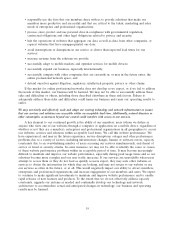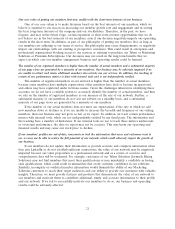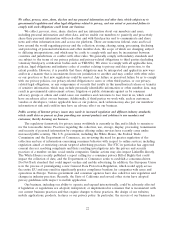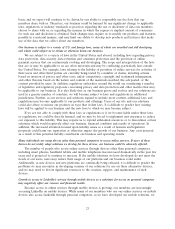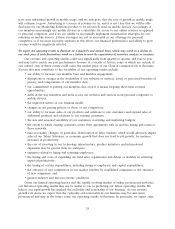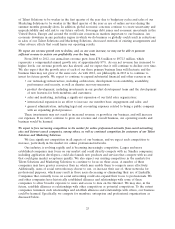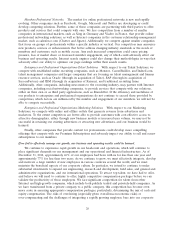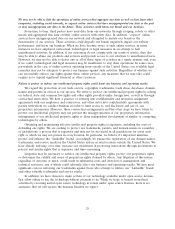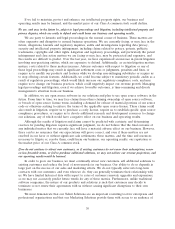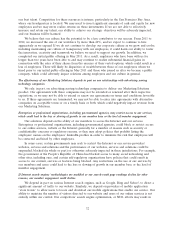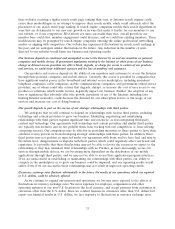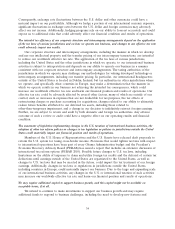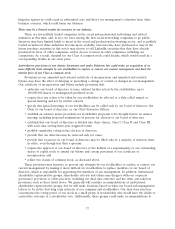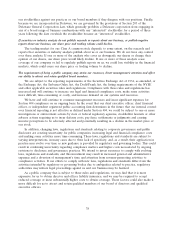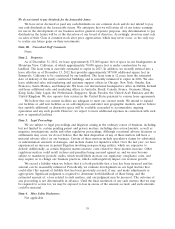LinkedIn 2012 Annual Report Download - page 31
Download and view the complete annual report
Please find page 31 of the 2012 LinkedIn annual report below. You can navigate through the pages in the report by either clicking on the pages listed below, or by using the keyword search tool below to find specific information within the annual report.We may not be able to halt the operations of online services that aggregate our data as well as data from other
companies, including social networks, or copycat online services that have misappropriated our data in the past
or may misappropriate our data in the future. These activities could harm our brand and our business.
From time to time, third parties have used data from our networks through scraping, robots or other
means and aggregated this data on their online services with other data. In addition, ‘‘copycat’’ online
services have misappropriated data on our network and attempted to imitate our brand or the
functionality of our services. These activities could degrade our brand, negatively impact our website
performance and harm our business. When we have become aware of such online services, in many
instances we have employed contractual, technological or legal measures in an attempt to halt
unauthorized activities. In addition, if our customers do not comply with our terms of service, they also
may be able to abuse our products and services and provide access to our solutions to unauthorized users.
However, we may not be able to detect any or all of these types of activities in a timely manner and, even
if we could, technological and legal measures may be insufficient to stop their operations. In some cases,
particularly in the case of online services operating from outside of the United States, our available legal
remedies may not be adequate to protect our business against such activities. Regardless of whether we
can successfully enforce our rights against these online services, any measures that we may take could
require us to expend significant financial or other resources.
Failure to protect or enforce our intellectual property rights could harm our business and operating results.
We regard the protection of our trade secrets, copyrights, trademarks, trade dress, databases, domain
names and patents as critical to our success. We strive to protect our intellectual property rights by relying
on federal, state and common law rights and other rights provided under foreign laws, as well as through
contractual restrictions. We have a practice of entering into confidentiality and invention assignment
agreements with our employees and contractors, and often enter into confidentiality agreements with
parties with whom we conduct business in order to limit access to, and disclosure and use of, our
proprietary information. However, these contractual arrangements and the other steps we have taken to
protect our intellectual property may not prevent the misappropriation of our proprietary information,
infringement of our intellectual property rights or deter independent development of similar or competing
technologies by others.
Obtaining and maintaining effective intellectual property rights is expensive, including the costs of
defending our rights. We are seeking to protect our trademarks, patents, and domain names in a number
of jurisdictions, a process that is expensive and may not be successful in all jurisdictions for every such
right or which we may not pursue in every location. In particular, we believe it’s important maintain,
protect and enhance the ‘‘LinkedIn’’ brand. Accordingly, we pursue the registration of our domain names,
trademarks, and service marks in the United States and in certain locations outside the United States. We
have already and may, over time, increase our investment in protecting innovations through investments in
patents and similar rights that is expensive and time-consuming.
Litigation may be necessary to enforce our intellectual property rights, protect our proprietary rights
or determine the validity and scope of proprietary rights claimed by others. Any litigation of this nature,
regardless of outcome or merit, could result in substantial costs and diversion of management and
technical resources, any of which could adversely affect our business and operating results. We may incur
significant costs in enforcing our trademarks against those who attempt to imitate our ‘‘LinkedIn’’ brand
and other valuable trademarks and service marks.
In addition, we have chosen to make certain of our technology available under open source licenses
that allow others to use the technology without payment to us. While we hope to benefit from these
activities by receiving useful open source technology in return under open source licenses, there is no
assurance that we will receive the business benefits we expect.
29


